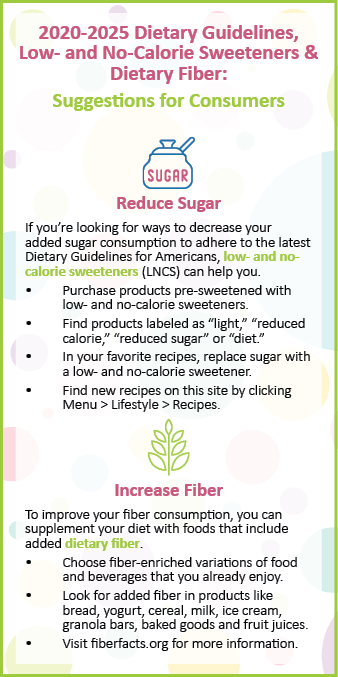
The 2020-2025 Dietary Guidelines for Americans (DGAs), released on December 29, 2020, offer recommendations to promote healthy dietary habits throughout all stages of life, including reducing added sugar, while considering individuals’ need customize their dietary choices to accommodate their unique lives and personal circumstances.
For the first time, the Dietary Guidelines Committee from the U.S. Departments of Agriculture (USDA) and Health and Human Services (HHS), the organizations involved in producing the DGAs, focused on offering nutritional guidance based on life stage, including birth to 24 months, pregnant and lactating women and older adults. The guidelines encouraged the importance of meeting food group needs with food and beverages that are nutrient-dense, high in fiber and low in added sugar, saturated fat and sodium. The Dietary Guidelines for Americans provides a framework intended to be customized to individual needs and preferences such as cultural and budgetary considerations.
For more information about the 2020-2025 Dietary Guidelines for Americans and its recommendations on topics in addition to low- and no-calorie sweeteners, refer to www.dietaryguidelines.gov.
Among the specific recommendations from the much-anticipated guidelines were several topics that touched on the use of low- and no-calorie sweeteners. Here are excerpts and highlights related to incorporating low- and no-calorie sweeteners in your diet.
“A healthy dietary pattern limits added sugars to less than 10 percent of calories per day. The major sources of added sugars in typical U.S. diets are sugar-sweetened beverages, desserts and sweet snacks, sweetened coffee and tea, and candy. Replacing added sugars with low- and no-calorie sweeteners may reduce calorie intake in the short-term and aid in weight management, yet questions remain about their effectiveness as a long-term weight management strategy.”

“Reducing added sugars is an important message to relay to our patients. Making them aware of where hidden sugars may lie, such as in juices and yogurts, and giving them guidance on swapping out these items for those containing low calorie sweeteners will help achieve the goal of lowering total intake of added sugars to no more than 10%,” said Keri Peterson, MD and medical advisor of the Calorie Control Council. “Low calorie sweeteners can serve an important role in diabetes management. Substituting sugars with low calorie sweeteners gives diabetics more flexibility in their diets, allowing them to enjoy sweet foods without affecting blood sugar. Furthermore, low calorie sweeteners may facilitate weight loss by decreasing overall energy intake, which can contribute to an improved HgbA1C.”
“The Dietary Guidelines supports healthy weight trajectories at each stage of life—appropriate weight gain during pregnancy and postpartum weight loss, healthy growth and development from infancy through adolescence, weight stability during mid-life, and healthy body composition late in life.”
“To help people meet the Guidelines and Key Recommendations, the following are important principles when making decisions about nutrient-dense food and beverage choices to achieve a healthy dietary pattern:
Low- and no-calorie sweeteners can be used as a tool in weight management when incorporated into one’s lifestyle with a balanced diet and exercise. The results of both short- and long-term randomized clinical trials (RCTs) have indicated that replacing sugar with LNCS leads to calorie reduction and weight loss.1
“Increasing intakes of fruits, vegetables, and replacing refined grains with whole grains to improve dietary fiber intakes is especially important during adulthood. Low intakes of dietary fiber, calcium, potassium and vitamin D are considered dietary components of public health concern because they are associated with health concerns. Individuals should be encouraged to make shifts to increase the intake of vegetables, fruits, beans, whole grains, and dairy to move intakes of these under consumed dietary components closer to recommendations.”
Despite the proven benefits of dietary fiber, most Americans, across all age groups, are not consuming the recommended daily amount. However, it is relatively easy to find foods containing dietary fiber. In addition to the fiber found naturally in fruits, vegetables, beans, nuts and whole grains, many foods have also been fortified with fiber. Studies have shown that added fibers offer the same health benefits as naturally occurring fibers. Fiber-enriched products include yogurt, cereals, breads, baked goods, ice cream and candies, and allow consumers to have more options for consuming their recommended daily fiber intake.



Reference: